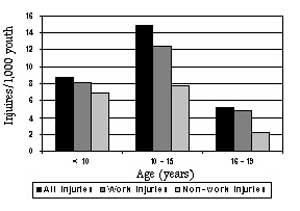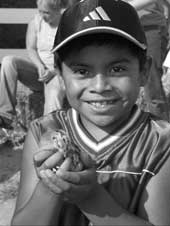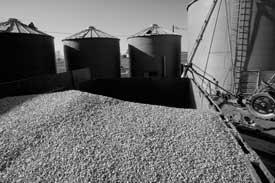| |
| Understanding how to create a safe farm environment is important for farm operators
and their families. Youth who live and work on farms are exposed to potentially
dangerous farm-related hazards more frequently than other youth. |
Content
Hispanic Farm Operations
Just the facts . . .
- In 2003, 47,200 farms were operated by Hispanics in the United States
- About 1/3 (17,300) of these farms reported having youth less than 20 years old living on them
- 34,500 youth lived on these Hispanic-operated farms
- 540 injuries (1.5 injuries/day) occurred to youth who lived on, worked on, or visited
these Hispanic-operated farms
- Nearly 2/3 (340) of the injuries were to youth who lived on the farm
- Between 1995 and 2002, 77 Hispanic youth died on farms (42 deaths/100,000 youth)
Hispanic Youth Fatalities on Farms,
1995-2002
- Of the 77 Hispanic youth who died on farms in the United States, most were between the
ages of 16 and 19
- The majority of deaths to Hispanic youth on farms were due to machinery (21%), such as
tractors; motor vehicles (18%), which include ATVs; and drowning (15%)
Non-fatal Injuries to Youth Living on Hispanic Farms, 2003
The most common sources for the 340 nonfatal injuries to youth living on a Hispanic farm were:
- Floors, walkways, ground (29%)
- Persons, animals, plants, minerals (21%)
- Vehicles (ATVs, tractors, automobiles, 17%)
The most common types of injury were:
- Broken bone (36%)
- Cut (15%)
- Bruise (13%)
The body parts most commonly injured were:
- Hand, wrist, finger (20%)
- Arm (17%)
Non-fatal injury rates (per 1,000) for youth
living* on Hispanic farms by age group, 2003

*Includes all individuals 0-19 years of age who live on a Hispanic farm operation.
How to Keep the Youth on Your Farm Safe
- Children do what they see...be a good role model for farm safety. Devote a day to FARM
SAFETY with your children.
- Inspect your farm for hazards to children. Remove as many hazards as possible. Mark
dangerous areas clearly with hazard signs.
- Provide an enclosed and supervised safe play area for children. Do not allow children
to play around machinery, workshops, storage buildings, or where work is occurring on the farm.
- Assign farm chores to youth that are appropriate for their age such as those recommended
in the North American Guidelines for Childhood Agricultural Tasks (NAGCAT).
Keeping Youth Safe Around Animals
- Teach youth how to handle and work with animals safely.
- Farm animals that are breeding, have newborns, or are sick can be aggressive - make sure
children have no contact with these animals.
- Children should wear proper protective clothing when handling animals. For example, youth
should always wear a helmet when riding horses.
- All household pets should have proper health checks and shots.
Keeping Youth Safe Around Machinery
- Do not allow extra riders on tractors, all terrain vehicles (ATVs) and other farm equipment;
follow the “ONE SEAT— ONE RIDER” rule.
- NEVER leave keys in the ignition of machinery or vehicles.
- Limit operation of ATVs, tractors, and machinery to older youth. ATV manufacturers recommend
that riders be at least 16 years of age for ATVs 400 cc or larger, and that they take an ATV
safety training course. Youth should not operate any ATV without wearing a helmet.
- Child labor laws require that hired youth be at least 16 years old to operate tractors
and machinery on farms, except for 14- and 15- year olds who have received operator certification. All
youth should be properly trained before operating tractors or machinery.
- Child labor laws do not apply to youth on their family’s farm. However, they are a
good guide for when youth are old enough to do hazardous work safely.
- Youth, like adults, should not operate farm tractors without a Roll-Over Protective
Structure (ROPS) and a seatbelt.
- Youth should not operate tractors or other vehicles on public roads without a
driver’s license.
Farm Youth Dies After Being Engulfed in Corn Inside of Steel Grain Bin |
1995 — A 13-year-old male farm youth died of injuries
sustained after he was engulfed in corn inside a grain bin. The youth and his father had
been using a portable auger to remove corn from the bin. The youth climbed the bin ladder
to remove the cover on the roof opening, and remained seated on the roof ladder to observe
the corn being removed from the bin. The youth apparently fell into the bin while his father
was moving the truck forward to be filled. |
|
Keeping Youth Safe Around Water
- Always supervise children when playing in or near water.
- All entrances to ponds, lagoons, pools, and manure pits should be restricted. All farm ponds
should have water safety and rescue equipment.
- Alcohol contributes to many teen drownings on farms. Talk to your teens about the
dangers of drinking and swimming.
- Never leave containers with standing water in areas where toddlers are present.
Farm operators who hire youth to work on their farm should be aware of all applicable child labor laws. |
For More Information
National Children’s Center for Rural and Agricultural Health and Safety
1000 North Oak Avenue
Marshfield, Wisconsin 54449
Telephone: 1-888-924-SAFE (7233)
Web: research.marshfieldclinic.org/children
North American Guidelines for Children’s Agricultural Tasks (NAGCAT)
Telephone: 1-888-924-SAFE (7233)
Web: www.nagcat.org
Farm Safety 4 Just Kids
P.O. Box 458
Earlham, Iowa 50072
Telephone: 1-800-423-5437; 515-758-2827
Web: www.fs4jk.org
U.S. Department of Labor
Frances Perkins Building
200 Constitution Avenue, NW
Washington, DC 20210
Telephone: 1-866-4-USA-DOL
Web: www.dol.gov/dol/topic/youthlabor/Agriculturalemployment.htm
INSURE KIDS NOW!!
Your State , and every state in the nation, has a health insurance program for
infants, children, and teens. The insurance is available to children in working families. Make a
free call to find out more about your State’s Program.
Children’s Health Insurance Program (CHIP)
U.S. Department of Health & Human Services
Telephone: 1-877-KIDS-NOW (1-877-543-7669)
Web: www.insurekidsnow.gov
To receive NIOSH documents or for more information about occupational safety and health
topics, contact:
1-800-CDC-INFO (1-800-232-4636)
1-888-232-6348 (TTY)
E-mail: cdcinfo@cdc.gov
Visit the NIOSH Web site at: http://www.cdc.gov/niosh
Visit the NIOSH Childhood Agricultural Injury Initiative site at:
http://www.cdc.gov/niosh/childag/
Safer · Healthier · People™
DHHS (NIOSH) Publication Number 2007-162
August 2007
Centers for Disease Control and Prevention
National Institute for Occupational Safety and Health
|
| 
 This document is also available in PDF format. This document is also available in PDF format.
2007-162.pdf
(2 pages, 1,292 KB)

|
|


